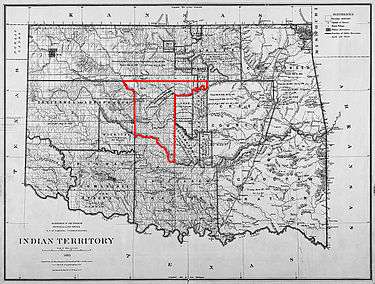Sooners

Sooners is the name given to settlers who entered the Unassigned Lands in what is now the state of Oklahoma before the official start of the Land Rush of 1889. President Grover Cleveland officially proclaimed the Unassigned Lands open to settlement on March 2, 1889 under the Indian Appropriations Act. The name derived from the "sooner clause" of the act, which stated that anyone who entered and occupied the land prior to the opening time would be denied the right to claim land.[1]
According to the Encyclopedia of Oklahoma History and Culture, the designation Sooner initially had a very negative connotation. However, the negative connotation began to change by the time of statehood, and is no longer considered negative by most residents.. In 1908, University of Oklahoma football team adopted the nickname "Sooners." The U.S. state of Oklahoma has been popularly nicknamed the "Sooner State" since the 1920s.[1]
Characteristics
Sooners were often deputy marshals, land surveyors, railroad employees, and others who were able to legally enter the territory early.[2] Sooners who crossed into the territory illegally at night were originally called "moonshiners" because they had entered "by the light of the moon." These Sooners would hide in ditches at night and suddenly appear to stake their claim after the land run started, hours ahead of legal settlers.[1]
Relationship with Boomers
The term Boomer relating to Oklahoma refers to participants in the "Boomer Movement," white settlers who believed the Unassigned Lands were public property and open to anyone for settlement, not just Native American tribes. Their reasoning came from a clause in the Homestead Act of 1862, which said that any settler could claim 160 acres (0.65 km2) of public land.[3] Some Boomers entered and were removed more than once by the United States Army.[4]
Those who actually observed the official start of the land run and began the race for free land often found choice sections of land already occupied by Sooners or, in some cases, by Boomers. Problems with Sooners continued with each successive land run; in an 1895 land run as much as half of the available land was taken by Sooners. Litigation between legitimate land-run participants and Sooners continued well into the 20th century, and eventually the United States Department of the Interior was given ultimate authority to settle the disputes.[1]
Sports
In 1908, the University of Oklahoma adopted "Sooners" as the nickname of its football team, after having first tried "Rough Riders" and "Boomers". Eventually, Oklahoma became known as "The Sooner State."[1] The school fight song is titled "Boomer Sooner." The school "mascot" is a replica of a 19th Century covered wagon, called the "Sooner Schooner."
References
- 1 2 3 4 5 Blochowiak, Mary Ann. "Sooners". Oklahoma Historical Society. Archived from the original on 2006-02-18. Retrieved 2007-05-11.
- ↑ "The Land Run – Boomers vs. Sooners" (PDF). 2007-2008 Proposed Budget. City of Tulsa, Oklahoma. Retrieved 2007-05-11.
- ↑ "The State of Oklahoma". Netstate.com. Retrieved 2007-05-22.
- ↑ Rister, Carl Coke (1942). Land Hunger, David L. Payne and the Oklahoma Boomers. Norman, Oklahoma: University of Oklahoma Press. pp. 41, 45–50.
External links
- "Home Page". Oklahoma Historical Society.
- "Oklahoma Digital Maps: Digital Collections of Oklahoma and Indian Territory". Oklahoma State University.
- Hoig, Stan (2009). "Boomer Movement". Encyclopedia of Oklahoma History and Culture (online ed.). Oklahoma Historical Society.